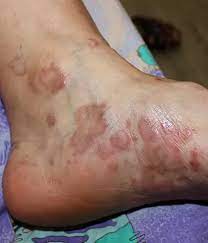
Lichen planus is a chronic inflammatory condition that affects the skin, hair, nails, and mucous membranes. It can appear anywhere on the body, but is most commonly found on the wrists, ankles, and lower back. Here are some key facts about lichen planus:
Causes:
- The exact cause of lichen planus is unknown, but it is believed to be an autoimmune disorder in which the body’s immune system attacks the skin and mucous membranes.
- Certain medications, such as beta-blockers and non-steroidal anti-inflammatory drugs (NSAIDs), can trigger an outbreak of lichen planus in some people.
Symptoms:
- Lichen planus typically appears as small, flat-topped, itchy, reddish-purple bumps or spots on the skin or mucous membranes.
- In some cases, the bumps may develop into blisters or open sores.
- Lichen planus can also affect the nails, causing ridges, grooves, and thinning.
Diagnosis:
- A diagnosis of lichen planus is usually made based on the appearance of the skin or mucous membrane lesions.
- In some cases, a skin biopsy may be necessary to confirm the diagnosis.
Treatment:
- Treatment for lichen planus depends on the severity of the condition and the location of the lesions.
- Mild cases may not require treatment, but topical or oral corticosteroids, retinoids, or immunosuppressive medications may be prescribed for more severe cases.
- Symptomatic relief measures, such as cool compresses and oatmeal baths, can help relieve itching and discomfort.
Prognosis:
- Lichen planus is a chronic condition, but it typically resolves on its own within 6-12 months.
- In some cases, lichen planus can cause scarring or permanent changes in skin colour or texture.
- Rarely, lichen planus can affect the oesophagus, genitals, or other internal organs, leading to more serious complications.
